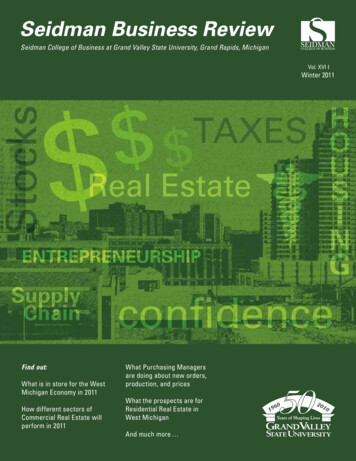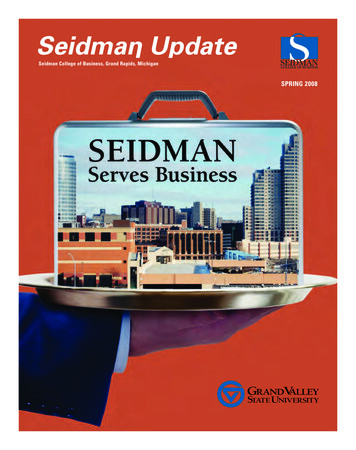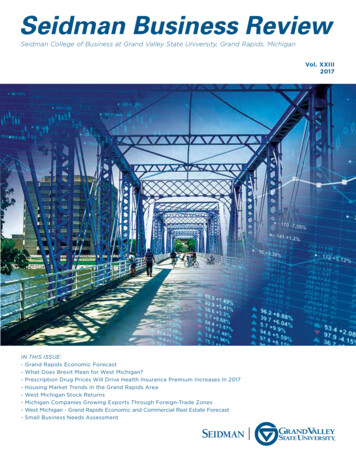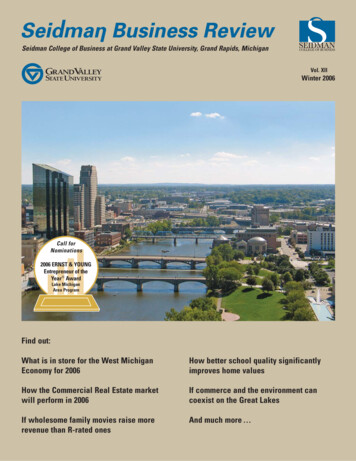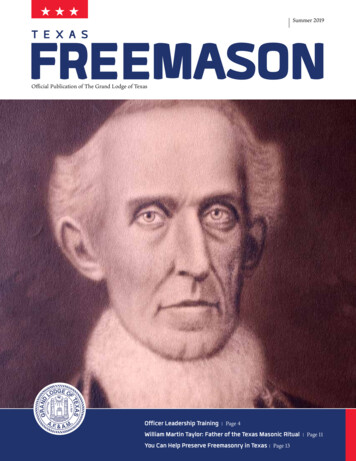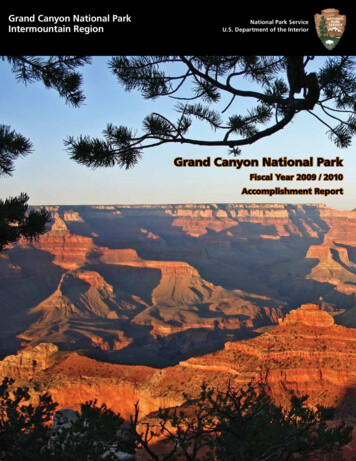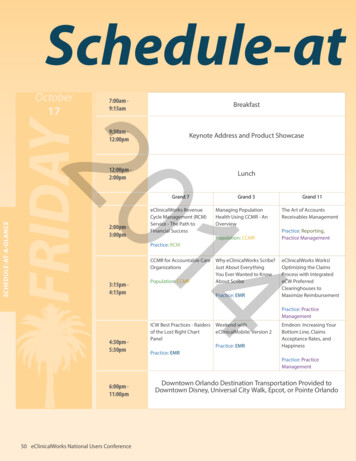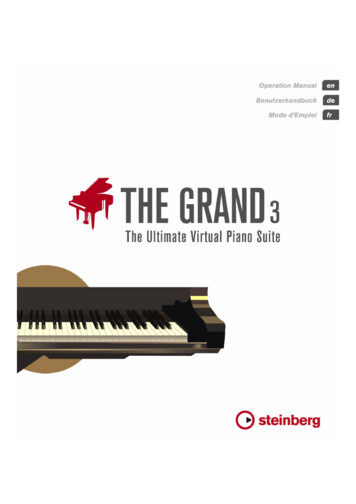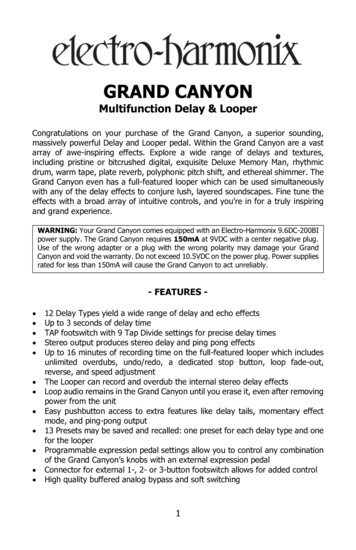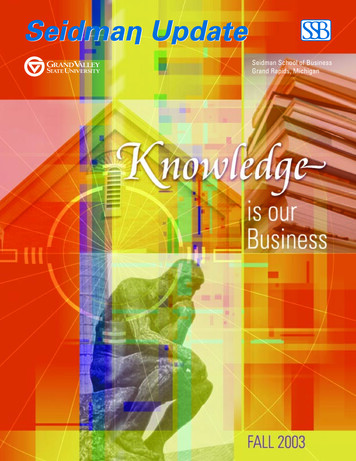
Transcription
Seidman School of BusinessGrand Rapids, Michigan
DEAN’S ADVISORY BOARDJohn W. ReifelInterim DeanL. William SeidmanHonorary ChairDwane BaumgardnerRetired, Donnelly CorporationCharles E. BennettPolymer Products, Inc.Carole D. BosBos & Glazier, P.L.C.Keith R. BurnsErnst & Young LLPJohn C. CanepaCrowe Chizek & CompanyEdward J. ClarkAmerican Seating CompanyJoseph A. DavioComerica BankJohn L. DeMariaQuoin, Inc.Harvey N. GaineyGainey CorporationRobert GrootersRG CompaniesDoyle A. HayesPyper Products CorporationThomas W. HillerBDO Seidman, LLPEarl D. HoltonMeijer, Inc.David HoogendornErnst & Young LLPJ. C. HuizengaWestwater GroupWilliam W. Jack, Jr.Smith, Haughey, Rice & RoeggeDorothy A. JohnsonAhlburg CompanyJeffrey B. KaneBDO Seidman, LLPDerek D. KaufmanKaufman Peters, LLCFred P. KellerCascade EngineeringRobert L. (Buzz) KersmanLorin IndustriesChristopher B. MontaguePlante & Moran, LLPMark P. OlesnavagePerrigo CompanySeymour K. PadnosLouis Padnos Iron & Metal Co.Jon E. PikeBeene Garter LLPSharron J. ReynoldsHuntington National BankNancy SkinnerNancy Skinner & Associates, Inc.Stephen A. Van AndelAlticor Inc.Charles C. Van LoanIndependent Bank CorporationCurt WellsHuntington National BankDan WiljanenGlobal Executive SearchFromthe Deanfter four years of leading SSB to the next level (see the following page), Dean David E.Mielke decided to step down as Dean this past June. Under Dean Mielke’s leadership SSB’s enterprise expanded, both internally in terms of program and teachinginitiatives, and externally in outreach to the community. Dave was thanked for hisvisionary service to SSB at a reception in August.A Dean Search Committee has been formed and is in the process of recruiting our nextDean. Assuming that the search process proceeds as planned, a new Dean will assume dutieshere next July 1. Until that time, I have been appointed as Interim Dean. When I was beingintroduced as the Interim Dean at a gathering late in the summer, someone asked where Icame from. I replied that I came from the “fourth floor.” I have been an economics professor at GVSU for over thirty years. My teaching interests are in microeconomics, urbaneconomics, and public finance. My research has concentrated on an array of housingissues ranging from housing demand to discrimination in housing markets.This year the business school will continue to modify and develop its strategic planfor AACSB International (Association for Advancement of Collegiate Schools of Business)reaccreditation. AACSB adopted a revised set of criteria for business school accreditationlast spring. In contrast to the old content standards that simply required that certainsubject matter be presented to business majors, the new standards require assurance oflearning. Accredited business schools must develop not only general education and management specific learning goals, but also assessment measures that can be used to measurethe amount of learning that has occurred. Feedback from these measurements must thenbe used to revise curriculum and improve learning outcomes.The theme of this issue of Seidman Update is “knowledge is our business.” This is trulya timely theme in light of the revised AACSB standards that now stress assurance of learning.Our faculty is the key here. Faculty members are involved in the creation of new knowledge,presenting relevant knowledge to students and making sure that students understand, andsharing their knowledge in ways that will benefit the West Michigan community.A— John W. Reifel,Interim Dean, Seidman School of Business
David Mielkecame envisioned took us to the next level.Family Owned Business InstituteFamily Owned Business Hall of FameCenter for EntrepreneurshipGreat Lakes Venture QuestPartnership with U.S. Department of CommerceErnst & Young Entrepreneurship AwardsReal Estate Forecast SeminarDirect Selling initiativeSmartZone initiativesMichigan Alternative and Renewable Energy CenterState Headquarters/Small Bus Technology Development CenterMichigan Small Business & Technology Development Center 3 million Public Service Commission grantE-CommerceSAP initiativeCurriculum enhancementStrategic PlanLaw School PartnershipPizza with the DeanMaster of Science in AccountingProfessional Development SeriesRecruiting, motivating, and rewarding faculty excellenceInternational Business MajorNew Product DevelopmentNewsmaker of the YearMove to DeVos CenterThird highest GMAT scores in State of MichiganGMAT Preparation WorkshopSeidman Dean’s Advisory BoardInternational Business ScholarsRaised entrance GPAFreshman admission for National Merit studentsIncreased enrollments 48% in 4 yearsRe-vamped faculty evaluation systemInternational exchange with Shanghai UniversityHired 17 new facultyDave E. Mielke served as Dean of the Seidman School of Business for a period of four years. This series ofphotos attempts to chronicle his many accomplishments as he led the School to new levels. The students,faculty, alumni, business community, and friends of Seidman and GVSU have benefited in numerous waysthrough his service.3
In this issue 565Seidman School Benefactor Honored in Washington, D.C.GVSU founding father and Seidman School supporterL. William Seidman was honored in Washington, D.C. forhis role in creating The Washington Campus Program25 years ago.6The Many Facets of New FacultyMeet SSB’s newest faculty. Seidman welcomes ninemembers with diverse backgrounds and interests.Seidman Update is a bi-annual publication ofGrand Valley State University’s Seidman Schoolof Business, Grand Rapids, Michigan.The Seidman School offers the Bachelor ofBusiness Administration (BBA), Bachelor ofScience (BS) or Bachelor of Arts (BA) inEconomics, Master of Business Administration(MBA), Master of Science in Accounting(MSA), and Master of Science in Taxation(MST) degrees. The school is fully accreditedby AACSB International.Project Coordinator:Vonnie HerreraEditors:Vonnie Herrera, Claudia BajemaUpdate Faculty Advisor:Paul Lane, Ph.D., E. Seidman ChairGraphic Design & Production:Ruth Oldenburg/Rainstick Studio102010 Managing Scholarly Work: A View from the TrenchesSSB Professor Stephen Margulis discusses the intersectionof scholarship and project management with respect toediting a scholarly journal.20 Secchia Shares Project for the Millennium with SSB AlumniAlumni visit new 1500-acre Millennium Park, which ishailed by Park Commission leader Peter Secchia as atribute to the Millennium from a community that thinksabout its future.Contents:Faculty:6–78910–1112–13The Many Facets of New FacultySeidman Stars — Faculty and Staff Recognized for ExcellenceClass ActsManaging Scholarly Work: A View from the TrenchesKnowledge is our BusinessInternational:14Building Knowledge through International Experiences15Supporting International ActivitiesSeidman in the Community:16Growing Technology Businesses through Shared Knowledge17Celebrating Entrepreneurship17Seidman Faculty Collaborate with The Economic Club18–19Faculty Key Resource in Carrying out our FOBI Mission!Alumni:2021212222Secchia Shares Project for the Millennium with SSB AlumniSpectrum Health CEO Defines Healthcare Value for SSB AlumniSeidman Alumni BoardAlumni NotesAlumni Golf OutingOther:352323David Mielke came envisioned took us to the next level.Seidman School Benefactor Honored in Washington, D.C.Great Lakes Entrepreneur’s QuestSeidman Business ServicesSeidman School of Business Mission StatementThe Seidman School of Business creates a rigorous learning environment with a student focus, regional commitment, and a globalperspective. The School strives to excel at innovation, the application of concepts, and the integration of knowledge.4Seidman Update Fall 2003
Seidman School Benefactor Honored in Washington, D.C.L.William Seidman, a founding father of Grand ValleyState University, was honored in Washington, D.C.in June at the 25th anniversary celebration of TheWashington Campus Program. GVSU representatives joinedseveral hundred others from around the country to recognizeSeidman who in 1978, with other visionary business leaders,created the program to provide public policy training forgraduate business students and corporate executives.Grand Valley, one of eight of the original consortium businessschools, sends about sixteen graduate students to Washington,D.C. each summer to gain a better understanding of howgovernment works. Today, seventeen schools form theconsortium, including Arizona State University, Universityof California-Berkeley, University of California-LosAngeles, Cornell, Indiana University, The University ofMichigan, The University of North Carolina, PurdueUniversity, and others.David Gergen,Commentator, atlecturn; RogerPorter of HarvardUniversity; andBill Seidman(foreground)Seidman, CNBC’s Chief Commentator, also served as Chair ofthe Federal Deposit Insurance Corporation from 1985–1991,was Dean of the business school at Arizona State from 1982to 1985, and provided service to three U.S. presidents —Ford, Reagan, and G. H. W. Bush. He continues to serve as afinancial consultant in many countries.As a founder of GVSU, Seidman played a key role in raisingover 1 million in initial funds and obtaining the charter thatcreated the University in1960. The Seidman School ofBusiness was founded through a generous gift provided by theSeidman Family Foundation in 1973 and was named after L.William Seidman’s father, the late Frank Edward Seidman, afounding partner of the accounting firm now known as BDOSeidman and advisor to President Franklin D. Roosevelt.Bill Seidman at lecturn; Vice President Dick Cheney (center), and DefenseSecretary Donald RumsfeldL. William Seidman continues to be involved with GVSU andthe Seidman School of Business.Bill Seidmanand VicePresidentCheneyPhotographs Courtesy of Doug DeMark Photographywww.gvsu.edu/ssb/5
Seidman FacultyThe Many FacetsThe Seidman School of Business is pleased tointroduce nine new faculty members this year.Asli Akbulut, Assistant Professor of ManagementMBA, Ankara University, Turkey; MS and Ph.D., Louisiana State,Information Systems and Decision SciencesResearch: electronic information sharing between organizationsand innovative uses of information technologies in an educational settingAlex Balan, Visiting Instructor of EconomicsBS, University Politehnica, Bucharest, Romania; MA and Ph.D.,Western Michigan University, Applied EconomicsResearch: the effect of insurance type on the cost and use ofemergency and outpatient medical servicesDenise de la Rosa, Associate Professor of AccountingBA, Wayne State University; Master of Accountancy, Ferris StateUniversity; Master of Arts, University of Southern California;Ph.D., University of North Texas, AccountingResearch: privatization of state-owned enterprisesVijay Gondhalekar, Assistant Professor of FinanceBS, University of Bombay, India; MBA, University of Akron;Ph.D., University of Pittsburgh, FinanceResearch: mergers and acquisitions, behavioral finance, andexploring issues about how the behavior of market participantsaffects security prices6Seidman Update Fall 2003
Seidman Facultyof New FacultyVipin Gupta, Assistant Professor of ManagementB.Com. (Hons), University of Delhi; MBA, IndianaInstitute of Managment – Ahmedabad; MA and Ph.D.,University of Pennsylvania, Managerial ScienceResearch: management, leadership, and entrepreneurshipin different cultures of the world; modeling the influenceof cultural forces on technological growthParag Kosalge, Assistant Professor of ManagementBachelor of Engineering, College of Engineering, India;Ph.D., Indian Institute of Management, MISResearch: object oriented organizational modeling,business processes, process redesign and automation,and SAP implementationAaron Lowen, Assistant Professor of EconomicsBA, University of Northern Iowa; MA and Ph.D.,University of Iowa, EconomicsResearch: to determine how real people incorporatenew information to make meaningful decisionsJennifer Pope, Assistant Professor of MarketingBA, College of Wooster; MBA and Ph.D., University ofTexas-Pan American, MarketingResearch: international business relationships, countryof origin, and international advertisingDennis Stovall, Affiliate Instructor of AccountingBS, Central Michigan University; MBA, Grand ValleyState UniversityResearch: British and Irish economiesCan You Match the FacultyMember to the Activity?(Answers found below)1. One new facultymember likessnow skiing andcycling and, infact, was his/herUniversity’s state cycling goldmedalist on the road and on the track.2. One new faculty member is a choirdirector, plays the piano, organ, andtrumpet AND singsevery Christmas ina group called theOriginal DickensCarolers.3. This new faculty member enjoysmaking friends in different cultures ofthe world and once sat with unknownscholars from 50 countries. Theyhave continued to interact over thepast six years, and this person servesas the PrincipalCo-Investigator ofthe worldwideGLOBE project.1. Denise de la Rosa, 2. Dennis Stovall, 3. Vipin Guptawww.gvsu.edu/ssb/7
Seidman Faculty & StaffSeidman Stars —Faculty and Staff Recognized for Excellencemerica’s Small Business Development Center Network recognized Nancy Boese, Regional Director for the MichiganSmall Business & Technology Development Center (MISBTDC), as Michigan’s 2003 “State Star.” SB(T)DC employeesfrom each state were recognized at the San Diego Conference onOctober 4, 2003. State Stars were recognized for exhibiting exemplary performance. Nancy was identified by her peers, statewide,for making a significant contribution to the state’s SBTDCprogram, as well as for showing a strong commitment to smallbusiness. Nancy Boese represents the best of the MI-SBTDCNetwork. Region 7 of the MI-SBTDC is housed in the SeidmanSchool of Business.Aaul Lane was appointed as the Esther Seidman Chair forhis innovative leadership in business. The Esther SeidmanEndowment was made possible by a generous gift from theSeidman Family Foundation in 1989 to recruit and maintainexcellent educational leadership.Professor Lane joined the Seidman School of Business in1998 and served as chair of the Marketing Department 2000 –2002. He has chaired the MBA Curriculum Committee, launchedan E-Commerce Certificate Program for the School, and helpeddevelop the international program initiative. In addition, heheads the team for the production of the Seidman Update and hasled the School in developing new products. His service in thecommunity as a youth leader and for many social causes, inaddition to providing consulting and service to boards, brings aunique set of experiences to Seidman.Professor Lane earned his B.A. from Earlham College, hisM.B.A. from Stetson University, and his Ph.D. from MichiganState University.Pancy Levenburg, AssistantProfessor of Marketing, washonored as the 2003 U.S. SmallBusiness Administration’s MichiganAdvocate of the Year for 2003. Aspecial presentation was made to herat a luncheon hosted by the EconomicClub in Jackson, Michigan.Nregg Dimkoff, Professor of Finance, wasnamed Grand Valley’s 2003 OutstandingEducator. Graduates selected Dimkoff forthe award and credit him as an astute communicator and intelligent observer of world capital.Dimkoff earned his Ph.D. from Michigan StateUniversity and joined Grand Valley’s faculty in1975. He was honored at the Grand ValleyCommencement ceremonies in April.G8Seidman Update Fall 2003
Seidman FacultyTrade-offstudents in Professor Gerry Simons’ Emerging Markets class had theopportunity to find out exactly how the Federal Government enforcestrade agreements with developing countries. Guest speaker WilliamH. Lash III, (left) Assistant Secretary of Commerce for Market Access and Complianceat the U.S. Department of Commerce’s International Trade Administration, shared theBush administration’s stance on pursuing trading agreements with a number of emerging markets, and his own duties in ensuring that countries follow the rules of thosetrade arrangements.SCLASSACTSLearning for Realtudents in Professor Vipin Gupta’s capstone class(above) were required to interview a furniture manufacturing firm in Grand Rapids to identify the factorsthat have enabled the firm to survive in this economicallychallenging market, including the transformational strategies being undertaken and needed for survival in the future.“Interviewing Brian Higgins, head of SteelcaseInternational Operations, helped us learn how a globalcompany runs and what it values,” explained Katie Foltice,Kelsey Schauman, and Melanie Thompson. Brenda Cusackshared that her group very much enjoyed interviewing theexecutive of John Widdicomb. “He was extremely responsive and helpful, and we think the face-to-face interview atthe company created a unique learning experience for us.”Many students were surprised at how friendly and receptiveSwww.gvsu.edu/ssb/the executives were tosharing information,and they realized thatindividuals sitting inimportant positions are“real people” workingdiligently to solve theircompanies’ challenges.Collectively, the studentswill make recommendationsback to the class on the policiesand strategies needed to help revive thefurniture manufacturing sector, which has been experiencing substantial upheaval over the last couple of years.9
Seidman FacultyManaging Scholarly Work:A View from the Trenchesby Stephen T. Margulis [1]Most scholars associate scholarship with preparing individualarticles (chapters, books)based on the scholarly demands of conducting research, developing theories,evaluating and reviewing topical areas,and the like. Allow me to offer a complementary perspective: the managementof scholarly work (i.e., the intersectionof scholarship and project management).I will base my discussion on three yearsediting a recent (June 2003), 210-page,single issue of a scholarly journal. Thetopic was privacy [2].How did this opportunity arise? I was usingmy sabbatical [3] to identify and readnew material on privacy. But, as I gotdeeper into privacy as a social andpolitical issue, I considered a volumeon privacy that could familiarize psychologists (my doctoral discipline) withcurrent issues.After the initiating idea, then what? I contacted a colleague, also interested inprivacy, to ask about co-editing an issueon privacy for the Journal of Social Issues(JSI). I chose the JSI because it is one ofthe few major journals in psychology thatallocates entire issues of the journal tospecific social issues. When it becameclear my colleague and I could not meldour ideas, he graciously allowed me topropose my ideas to the JSI. The JSIagreed that an issue on privacy wasviable. It took six months to findauthors, then to prepare a proposal. In10Seidman Update Fall 2003
the 100-page proposal, the authorsdescribed their 12 articles, and I providedthe justification for both the proposedarticles and the entire journal issue.How did you find 12 contributors? I neededto find scholars in specific areas who wereavailable, willing to work on mutuallyagreed upon topics, and experienced atpublishing scholarly work. To accomplishthis, I had to know a good deal aboutprivacy and who was contributing to thefield. Because some areas were relativelynew, I also relied, in part, on networkingskills I had honed in the 1970s at a federalresearch laboratory. I had found that, bycarefully selecting the first person to call, Icould usually locate a needed expert infive or fewer phone calls. My calls andemails took me throughout the U.S. andto five cities in Canada, Europe, and EastAsia. The networking worked. In one caseit worked in an unusual way: Those Icalled convinced me there was notenough good research on my topic for anarticle. So I dropped the topic.When I found potential contributors, Idescribed the proposed volume, and weshared our visions of their proposed articles. We would then negotiate theirarticles’ coverage. I preferred a tight fitbetween our visions. A loose fit was agamble I was willing to take if a contributor proposed an exciting alternative.Unfortunately, when creating an editedwork, losing contributors is a commonexperience. I lost three authors who quitfor very different reasons. I tried to makethose lemons into lemonade. I replacedone author to ensure at least 10 articles.In the other cases, I reallocated recapturedpages to contributors. Like most scholars,mine (and I include myself) gladlyaccepted additional pages for their articles.With everyone on board, what did it take tocomplete the journal issue? Getting published meant overcoming a sequence ofobstacles, starting with having my proposal approved, having articles acceptedby me and then by external reviewers, andthen having the resulting articles acceptedby me and, ultimately, by the journal’sown editor, who oversees the editors ofsingle issues.During the article acceptance phase, I hadtwo roles: as the issue editor and as a contributor, each with its own scholarlydemands. As the issue editor, I must knowenough about each author’s topic to evaluate an article’s completeness, coherence,sources, and persuasiveness, the qualityand organization of arguments, and eventhe mechanics of formatting. When I edit,I review articles from the author’s perspective and aim for a published product thatmakes the author look good. Editingrequires negotiation, tact, diplomacy, andhelping my authors in any way I can. For(most) authors, getting published meansaccepting requests to revise their manuscripts. However, there are limits to anauthor’s willingness to comply. I lost twoauthors because their tolerances wereexceeded. Consider the following: myauthors were being asked to make revisions by me, external reviewers appointedby the journal, and finally by the journal’seditor, often more than once. Tolerancescan be exceeded. As a contributor, I facedthe same demands as my other authors.There is much time and effort invested inidentifying, obtaining, and closely readingarticles and books, and in writing andrewriting and the constant hard thinkingand “sweating the details.”halfway through the process, I started anew clock that extended my end date.Fortunately, this author completed hisinitial manuscript relatively quickly, aplus. In addition, one author, a very seniorscholar, was to provide a capstone articlethat would present the “big picture” onprivacy and, in it, incorporate the contributions of the other contributors. The JSIencouraged this option. The wrinkle wasthat the author decided he could notbegin his article until he received all thearticles in final or near-final form. Thatreally extended my end date. Ironically, ashe prepared his drafts, his article transformed from a capstone into a stand-alonearticle. Fortunately, the journal’s editorapproved a shift in role (and what provedto be a fabulous article).Final thoughts. I am relieved the process isover. Editing and authoring were moreperspiration than inspiration. I am pleasedthat the journal issue is published. If andwhen it will have an impact is for thefuture to say. I gave it my best shot, but Iam also the guy who said about a peer’storrent of scholarly twaddle, “How manytrees died for his sins?”Why did it take three years? I initiallyexpected the process to take two years.However, when I replaced an author[1] The author is in the Management Department, Seidman School of Business.[2] The publication is “Contemporary Perspectives on Privacy: Social, Psychological, Political,” Journalof Social Issues, 2003, volume 59, number 2. For a free copy of the introductory essay and informationon ordering the volume, please send an email to Margulis@gvsu.edu.[3] It is time off for full-time scholarly activity, granted after seven years of full-time teaching, hence calleda sabbatical.www.gvsu.edu/ssb/11
Seidman Faculty12Seidman Update Fall 2003
Seidman faculty are Teaching 263 classes in Grand Rapids,Allendale, Holland, and Muskegon fall of 2003 Responsible for the delivery of 26,919 credithours fall of 2003 Mentoring and serving as role models for2,656 business students fall of 2003 Directing or mentoring students for study in9 countries Serving on 63 SSB and University committees Publishing at a rate of 119 articles, books,and proceedings per year Making presentations at a rate of 54conferences per year both nationally andinternationally Participating in more than 52 professionalorganizations and societies Writing business columns andregularly interviewing with local media Performing community service for more than30 organizations or causesSeidman faculty are Creating a rigorous learning environmentwith a student focus, regional commitment, anda global perspective Striving to excel at innovation, theapplication of concepts, and the integrationof knowledgeSeidman faculty areCommittedwww.gvsu.edu/ssb/13
Seidman InternationalBuilding Knowledgethrough InternationalExperiencesAbove left, Barcelona tour; left, London tour; above, London financial district tourHow do faculty facilitate learning inan international environment? Inthe summer of 2003, GVSU sponsored a number of programs around theworld. Four Seidman faculty members ledtwo of those programs. Gerry Simonsfacilitated an MBA course in France; whileJoe Godwin, Paul Lane, and JaideepMotwani traveled to England with a groupof undergraduate students.What does it take to impart knowledgeand to facilitate a successful learningexperience in another country? Facultymembers give a great deal of thought tomodifying the syllabus to take advantageof the unique environment. Considerationis also given to a location for the classes.Is the most ideal site a classroom or acompany, or perhaps a museum, a bank, abusiness association, or a local school?Different cultures offer opportunities aswell as challenges. What is it like to havea lecture from a French professor? How14are students prepared for understandingthe country’s culture? Joe Godwin founda wonderful video series on the historyof the British Isles and the UnitedKingdom that primed students for theirvisits to the palaces, castles, Romanruins in Bath, and Stonehenge.Given the brevity of the programs, whatexperiences optimize learning about cultureand international business? Last yearstudents studying in London were ableto meet with representatives of HermanMiller in Bath, Wolverine Worldwide,Deutsche Bank, International AccountingStandards Board, and many others.What historical monuments or resourcesare available? Museums have turned outto be favorites. This year the Londongroup visited the historical Londontheater district early, and the studentstook over from there, organizing manynights of theater events for themselvesand faculty. The financial district wastoured, including business monumentslike the Bank of England and Lloyds ofLondon. The Globe Theater featured anevening of Shakespeare, and the open airtheater at the famous Regent’s Park wasincluded for a light musical, “HighSociety.” Some visited St. Paul’s to see highchurch, Anglican style, and some traveledinto the country for the small villages andPerry Green, the home of the famoussculptor, George Moore.Program leaders are challenged to motivate students to explore more and more.Not only did students fan out all overthe UK, visiting the Lake Country andseashore, but they also covered manyother European countries includingSpain, Italy, Switzerland, France,Germany, and Holland. Some studentstraveled to explore, while others followedsports to Wimbledon, the Scottish Open,and the Tour de France. All shared inthe richness of knowledge acquired in adifferent environment.Seidman Update Fall 2003
Seidman InternationalSupportingInternationalActivitiesGVSU students visit the beautiful countryside of the French Alps in Grenoble.International Trade Education and Assistance in West MichiganSSB’s International Business Programand the Van Andel Global TradeCenter recently received a federalgrant of 161,000 for two years to supporta new project called I-TEAM2. I-TEAM2,International Trade Education andAssistance in West Michigan 2, is thesecond phase of a similar initiative thatended in June 2003. I-TEAM2 is a neweffort that will enrich international businesseducation at SSB and provide internationaltrade assistance to the business communityof West Michigan. I-TEAM2’s goal is tostrengthen our competencies, develop innovations, and apply our expertise ininternational business education to activities targeted to students, faculty, and thebusiness community of West Michigan.Carol Sánchez, SSB associate professor ofmanagement and director of internationalbusiness programs, and Jeff Meyer, executive director of the Van Andel GlobalTrade Center (VAGTC) are co-directors ofI-TEAM2. “On the academic side, ourbiggest goal is to help more SSB studentsstudy abroad and develop their capabilitiesto do business internationally,” Sáncheznotes. “We will do that by developing ourstudy abroad programs, providing scholarships, and encouraging our faculty to getmore international teaching and researchexperience as well.”I-TEAM2’s success is its collaborativeapproach that brings together several GVSUunits, West Michigan companies, and community organizations. Key GVSU unitsinvolved, in addition to SSB and VAGTC,www.gvsu.edu/ssb/are the Modern Languages Department andthe Padnos International Center. WestMichigan organizations involved includeclient companies of the VAGTC, the WestMichigan World Trade Association, theWorld Affairs Council, the Michigan SmallBusiness Development Center, the GrandRapids Area Chamber of Commerce, andthe U.S. Department of Commerce. Thiscreates a sizeable support network toaccomplish three common objectives:1. To create and expand internationalbusiness activity among small andmedium-sized firms in WestMichigan. Activities include trainingin trade management and individualtrade counseling with local small andmedium-sized companies.2. To strengthen the quality andquantity of international businesseducation at SSB. Activities includean “Early Interest” program ininternationa
created the program to provide public policy training for graduate business students and corporate executives. Grand Valley, one of eight of the original consortium business . BS, Central Michigan University; MBA, Grand Valley State University Research:British and Irish economies Seidman Faculty (Answers found below) 1. One new faculty member .
